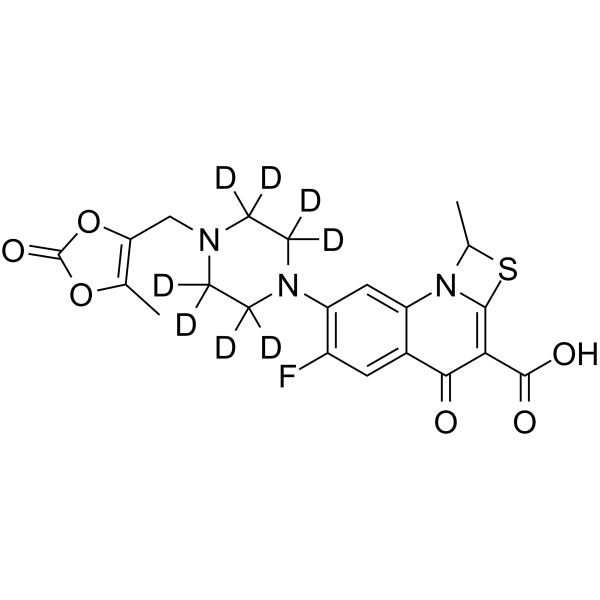Prulifloxacin-d8
Modify Date: 2025-08-26 16:16:05

Prulifloxacin-d8 structure
|
Common Name | Prulifloxacin-d8 | ||
|---|---|---|---|---|
| CAS Number | 1246819-37-3 | Molecular Weight | 469.51 | |
| Density | N/A | Boiling Point | N/A | |
| Molecular Formula | C21H12D8FN3O6S | Melting Point | N/A | |
| MSDS | N/A | Flash Point | N/A | |
Use of Prulifloxacin-d8Prulifloxacin-d8 (NM441-d8) is the deuterium labeled Prulifloxacin. Prulifloxacin (NM441) is an orally active fluoroquinolone antibiotic with a broad spectrum of activity against Gram-positive and -negative bacteria. Prulifloxacin is a prodrug of a thiazeto-quinoline carboxylic acid derivative Ulifloxacin (NM394). Prulifloxacin has the potential for lower urinary tract infections and exacerbations of chronic bronchitis[1][2]. |
| Name | Prulifloxacin-d8 |
|---|
| Description | Prulifloxacin-d8 (NM441-d8) is the deuterium labeled Prulifloxacin. Prulifloxacin (NM441) is an orally active fluoroquinolone antibiotic with a broad spectrum of activity against Gram-positive and -negative bacteria. Prulifloxacin is a prodrug of a thiazeto-quinoline carboxylic acid derivative Ulifloxacin (NM394). Prulifloxacin has the potential for lower urinary tract infections and exacerbations of chronic bronchitis[1][2]. |
|---|---|
| Related Catalog | |
| In Vitro | Stable heavy isotopes of hydrogen, carbon, and other elements have been incorporated into drug molecules, largely as tracers for quantitation during the drug development process. Deuteration has gained attention because of its potential to affect the pharmacokinetic and metabolic profiles of drugs[1]. |
| References |
| Molecular Formula | C21H12D8FN3O6S |
|---|---|
| Molecular Weight | 469.51 |
| InChIKey | PWNMXPDKBYZCOO-SQUIKQQTSA-N |
| SMILES | Cc1oc(=O)oc1CN1CCN(c2cc3c(cc2F)c(=O)c(C(=O)O)c2n3C(C)S2)CC1 |